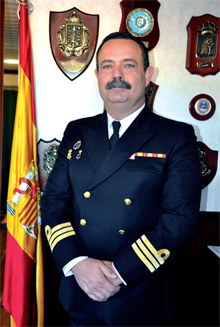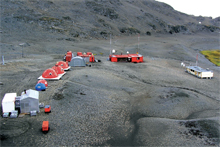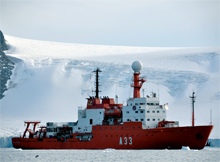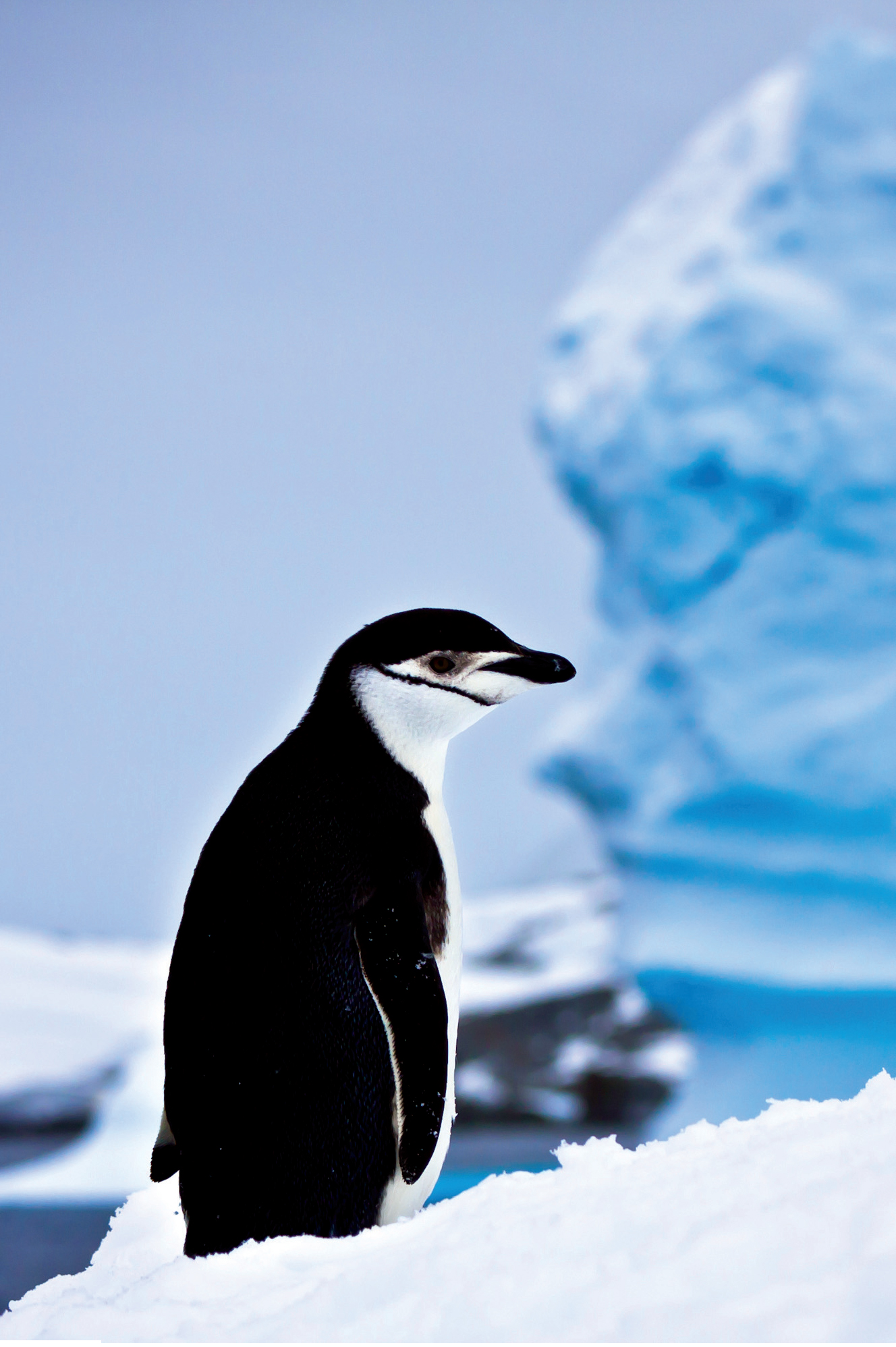Commander Juan Antonio Aguilar: Frigate Captain BIO HespéridesMISCELLANEOUS
Frigate Captain Juan Antonio Aguilar Cavanillas was born in Madrid (Spain) in 1960. He joined the Spanish Naval Academy in 1980, and was commissioned as ensign of the Royal Spanish Navy in 1985. He is a systems analyst and specialist in hydrography, and was awarded a diploma in operational research by the Naval Postgraduate School of Monterey, California. He has served on the corvette DIANA, the training ship JUAN SEBASTIÁN DE ELCANO and the hydrographic ship MALASPINA, of which he was Second Officer.
On land, he has held posts in the Fleet Tactical Programs Center, the Navy’s Cabinet of Operative Military Research (GIMO) and the Naval Hydrographic Institute. He has been commander of the POLLUX and MALASPINA hydrographic ships. He has been the Commander of the HESPÉRIDES oceanographic research ship since 18 June 2009.
“The Antarctic Treaty expresses the intention that the ice continent should continue to be used solely for peaceful purposes” It might seem that there is nothing left to discover on our planet, and indeed that no international agreements are respected. Nevertheless, the ice of the Antarctic and the waters that surround it still hold some keys to understanding the behaviour of the Earth and to forecasting how it will develop. Moreover, this continent is the subject of the Antarctic Treaty which -since 1961- has guaranteed its neutrality as well as the protection of its environment and the natural resources in which it abounds. But in order to carry out research in this glacial region, it is necessary first to reach Antarctica and then to be able to rely on a human team backed up by highly sophisticated technical equipment. Thanks to the detailed explanations given by Commander Aguilar in this interview, we shall learn how the Spanish vessel Hespérides is making it possible to accomplish this important international scientific mission.
12 March 2010 marked 20 years since the
launch of the Hespérides, prompting us to
wonder how the idea of building a vessel
for the purpose of international oceanographic
research took shape in Spain. Does the
name Hespérides have any particular significance?
The idea of building the Hespérides materialized
during the Second Week of Marine Studies
held at Cartagena (Murcia–Spain) in November
1984, following Spain’s signing of the
Antarctic Treaty two years previously. During
that week, there were discussions which led
to the conclusion that it would be appropriate
for Spain to have an oceanographic vessel
with Antarctic navigation capabilities, due
not only to our presence on that continent in
the form of the Juan Carlos I Base and the
Gabriel de Castilla station, but also to the interest
shown in it by Spain’s scientific community.
The name of the ship alludes to Greek mythology.
The Hesperides were nymphs who guarded
the Tree of Knowledge, which is also the
logo of the Spanish National Research Council
(CSIC).
The Hesperides were nymphs who guarded the Tree of Knowledge, which is also the logo of the Spanish National Research Council (CSIC)
Which organizations finance your activities,
and which areas of knowledge are covered
by your research projects?
The scientific research undertaken on board
the Hespérides is basically directed and financed
by the National Research and Development
Plan; responsibility for the scientific
management of the vessel (as part of the
“Major Infrastructure”) lies with the Ministry
of Science and Innovation (MICINN) acting
through the Commission for Coordination
and Support for the Activities of Oceanographic
Vessels (COCSABO). Various bodies
from other ministries also participate in this
Commission.
The logistical support and the technical and
scientific personnel required to undertake
the missions are provided by the Marine
Technology Unit (UTM) of the Spanish National
Research Council (CSIC). It should be
remembered that the vessel and its equipment
both belong to the Spanish Navy and
this also entails the presence of the Ministry
of Defense.
The ship carries out a wide variety of tasks
covering the different fields of oceanographic
research: hydrography as well as biological,
geological and seismological studies, and research
into marine physics and biochemistry,
to mention only a few.
The ship carries out a wide variety of tasks covering the different fields of oceanographic research: hydrography as well as biological, geological and seismological studies, and research into marine physics and biochemistry
Which scientific work can be undertaken
with the equipment available on board?
The Hespérides oceanographic research
vessel accommodates several laboratories
where research can be undertaken in various
scientific disciplines; these include a
low-temperature laboratory (kept at -20ºC),
what is known as the “Wet Process Unit” with
a continuous distribution circuit for surface
seawater, and one laboratory which is specifically
equipped for work with radioactive
isotopes, with capacity for storing the waste
residues produced.
Key items of the permanent scientific equipment on board include two multibeam echosounders,
one for deep water down to 11,000
meters (EM-120) and the other for shallow
water down to 600 meters; two monobeam
echosounders, the EK-60 to quantify biomass
and the EA-600 for bathymetric/hydrographic
work, one TOPAS seismic profiler with sediment
penetration capability of up to 250 meters,
one Acoustic Doppler Current Profiler
(ADCP) and two seismic shooters.
One of the most frequently used items of
equipment is the CTD dipping sounding line,
which can reach depths of as much as 6,000
meters to collect samples of water simultaneously
at different levels; this is normally
used to measure conductivity, temperature
and turbidity and for fluorometry. We can
also use 10- and 20-foot containers to carry
other items, in particular the equipment
used on our seismic assignments (shooters
and streamers, or marine cables). The vessel
can also launch radiometers, fishing nets,
drift bottles, corers (used to obtain samples
from the seabed with lengths of up to 10
meters) and trawls to obtain samples from
the seabed as well as the rest of the water
column.
The ship also has a meteorological station
linked to the TERASCAN system, which can
receive and fully process real time data from
satellites in the NOAA (National Oceanic and
Atmospheric Administration) series, and can
also handle various levels of processing for
data from other satellites: GOES, GMS, METEOSAT,
FY, DMSP, ERS, SPOT and CZCS.
How is the route of the Hespérides vessel
tracked from land and how are communications
handled?
The vessel has various satellite communication
systems -INMARSAT, SECOMSAT,
IRIDIUM and TERASCAN- which can receive and fully process real time data from satellites
in the NOAA series. This provides cover with
global capacity, including high latitudes. It
also has VHF, UHF and HF radio voice and
data communication equipment.
Ice navigation calls for some specific operating methods and safety precautions, especially in areas where cartography is poor and often inaccurate
What logistical support is provided by the
Hespérides vessel and its crew for the Spanish
Antarctic bases, “Juan Carlos I” on Livingston
Island and “Gabriel de Castilla” on
Deception Island?
In actual fact, logistical support for the Antarctic
bases is mainly provided by another
Spanish Navy vessel, the Las Palmas oceanographic
research ship. This vessel is responsible
for transporting staff and supplying
water, food and spare parts to the bases,
and for removing waste. Nevertheless, the
Hespérides often assists the Spanish bases
and others belonging to other countries, for
example by transporting relief staff.
Who draws up the safety documentation for
the Hespérides vessel? Which particular
procedures are required for navigation in
Arctic and Antarctic waters?
Navigation in waters where there is ice calls
for some specific operating methods and
safety precautions. We must also bear in
mind that these are areas where cartography
is poor and often inaccurate. All these factors,
together with the fact that GPS positioning systems
are not reliable at these latitudes, make
it necessary to establish special navigation
procedures. The documentation for polar navigation
is drawn up by the vessel crew on the basis of lengthy experience on board the
Hespérides, and it is subsequently approved
by the Navy. The officers of the Hespérides
also attend specific courses on polar navigation
in Chile and Argentina.
How does insurance cover operate in cases
of general average, towing, collision or
other more complex situations?
In fact, the Hespérides vessel is not insured
by any company as such, because it is a vessel
that belongs to the Spanish Navy which
manages all actions to be taken in case of an
exceptional event of this sort.
What health and medical cover can be
provided for personnel on board if necessary?
And what happens if personnel have
to be transferred to land or repatriated to
Spain?
A doctor and a medical assistant are always
on board during our missions. The vessel has
a sick bay for primary medical care, and an
X-ray room. If personnel have to be transported
ashore or repatriated, the Navy handles
all the transfers. If an emergency evacuation
by helicopter became necessary, it would be
coordinated with the marine rescue services
of the relevant country, or its navy. I should
point out that everyone has to pass a specific
and mandatory medical examination before
embarkation.
The Navy personnel have a group insurance
policy taken out by the Ministry of Defense.
Civilian personnel on board also have their
own policy.
Let’s talk about some difficult situations
that the Hespérides oceanographic research
vessel has experienced. Is it true that it had
to assist a tourist boat in Antarctic waters in
February 2009?
Yes indeed, the inclement Antarctic climate
and the difficulties of navigation in polar regions
sometimes lead to complex situations
for vessels working in this area.
In February 2009, we received a call for help
from the Marine Rescue Service at Ushuaia
(in southern Patagonia, Argentina). A passenger
vessel had run aground on the coast
of Audrey Island. The katabatic winds blowing
down from the glaciers and the sea current
made it impossible to refloat the ship. As we
were the nearest vessel, we went to assist.
The divers from the Hespérides reconnoitered
the hull to assess the situation and to look for
any holes below the water-line or fuel leaks.
We continued to support the ship until all the
passengers could be evacuated and later on,
when the tide came in and the weather conditions
improved, it was able to leave.
Are there any other ships in the world that
carry out oceanographic research, so that
scientists can be exchanged and knowledge
and experience can be shared?
In Spain alone, there are 18 other vessels
that carry out oceanographic work. Some of
them belong to the Spanish Oceanographic
Institute, and others are operated by the
CSIC, SEGEPESCA (General Secretariat for
Marine Fisheries) and also the Naval Hydrographic
Institute. However, it is true that the Hespérides is the most important of these
ships, the one with the best multidisciplinary
versatility, and the only one that is able to navigate
polar waters.
Many of the major world powers are involved
in oceanographic research, and countries
such as the USA, France, the UK and Canada
have large fleets.
We often carry scientific personnel from foreign
organizations on board the Hespérides,
thanks to cooperation among various universities.
And we frequently carry an observer
when we are working in waters belonging to
other countries. Last year, we were accompanied
by researchers from France, the UK,
Germany, Portugal, the USA, Brazil, Chile,
Argentina and China.
The Hespérides is the most important Spanish oceanographic research ship, the one with the best multidisciplinary versatility, and the only one that is able to navigate polar waters
The Antarctic Treaty
This is a composite framework of legal regulations at international level. It recognizes the Antarctic as a region of interest for the entire human race, and expresses the intention that it should continue to be utilized solely for peaceful purposes, and should not become the scene or subject of international disagreement. Various other accords have been drawn up to flank the Antarctic Treaty: the Protocol on Environmental Protection to the Antarctic Treaty, the Convention for the Conservation of Antarctic Seals, the Convention for the Conservation of Antarctic Marine Living Resources and the Convention on the Regulation of Antarctic Mineral Resource Activities, all of which make up the Antarctic Treaty System.
The Antarctic Treaty was drafted in 1959 and came into force in 1961. It was initially signed by the governments of Argentina, Australia, Belgium, Chile, France, Japan, New Zealand, Norway, South Africa, the former USSR, the UK and the USA. Further countries then acceded to the treaty in two categories: consultative parties (up to a total of 28) and acceding parties (19 countries).
Spain signed the Antarctic Treaty in 1982 and became a consultative party in 1988. Like the other members, Spain is committed to global protection of the environment and the dependent and associated ecosystems. It also undertakes to contribute toward the establishment of a sound basis to continue and develop international scientific cooperation in the Antarctic, underpinned by freedom of research. For this purpose, Spain has two scientific stations. One of these is managed by the Ministry of Science and Innovation through the CSIC: this is the “Juan Carlos I” Spanish Antarctic Base, located on Livingston Island. The second station is managed by the Ministry of Defense through the Spanish Army: this is the “Gabriel de Castilla” Spanish Antarctic Base, located on Deception Island. To support these bases, as mentioned above, we rely on the Las Palmas oceanographic research vessel as the main logistical support ship, and the Hespérides oceanographic research vessel also provides support as necessary, bearing in mind that its main mission is oceanographic research in the waters near the Antarctic continent.
A crew aboard a “green ship”
All the crew are of Spanish nationality except for one sailor who is a national of Uruguay; the crew comprises the commander, 10 officers, 10 non-commissioned officers and 35 petty officers and seamen, including four women.
The vessel also has capacity to carry 37 additional passengers as technical and scientific staff.
As regards waste management, the vessel is equipped to comply with the strictest requirements of the Antarctic Treaty. Waste is separated on board and the ship is equipped with a crusher, an incinerator and a compactor so that it can be stored on board until arrival in port. There is also a waste water treatment plant on board. We can proudly claim that the Hespérides vessel is a “green vessel”.

 Hespérides vessel in the Antarctic
Hespérides vessel in the Antarctic
 Juan Carlos I Antarctic Base on Livingston island. MICINN
Juan Carlos I Antarctic Base on Livingston island. MICINN
 Hespérides vessel in the Antarctic
Hespérides vessel in the Antarctic
 Hespérides vessel in the Antarctic
Hespérides vessel in the Antarctic

 Antarctic view from the Galileo space probe. NASA/courtesy of nasaimages.org
Antarctic view from the Galileo space probe. NASA/courtesy of nasaimages.org


